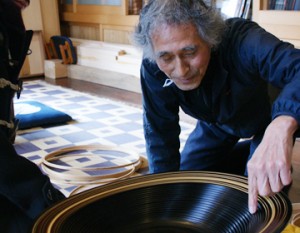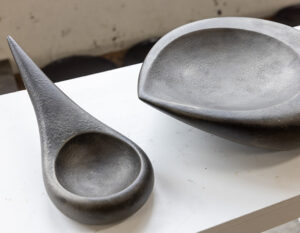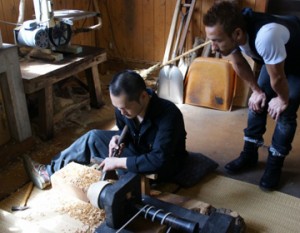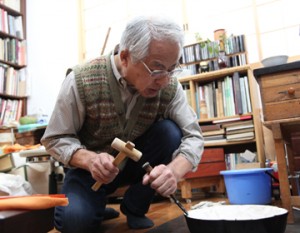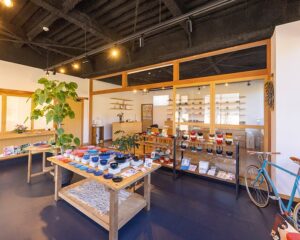Domestic lacquer that can be collected only once in 10 years
“We tap lacquer for only 1 year after allowing the tree to grow for 10 years. The tree is then cut down. This process is called ‘koroshi kaki (killing tap)’ and is essential in collecting the highest quality of lacquer. In other countries, they tap for up to 3 years, but in Japan, we only tap for 1 year and do our best to collect the very best quality lacquer.” We spoke with Mr. Yuzo Tobita, master lacquer tapper who was been a lacquer tapper for 66 years, earning him the Yellow Ribbon Medal.
“Lacquer tapping” is the process of tapping the sap that is used for lacquer in Japanese lacquer art and woodcraft.
The word “tapping” comes from the metal tool that is used to scrape the trunk of the tree.
Lacquer is highly resistant to bacteria and sturdy, making it ideal for craftwork, as well as architecture and daily items. Japanese lacquer work has a great reputation overseas, not only as a coating but as a design. Because the technique is so intricate, lacquer work is sometimes referred to as “japan”, a sign that it is symbolic of Japanese craftsmanship. Daigo city in Ibaraki prefecture is known for its abundance of nature. It is also known for top quality lacquer. Ibaraki ranks second in lacquer production, and the bulk is from Daigo city. There are about 10,000 lacquer trees in the city where Mr. Tobita and fellow members of the Daigo Lacquer Preservation Group continue their efforts to preserve the culture.

Can’t waste even a drop
We visited an area with about 2000 lacquer trees. Only about 200 of these trees are tapped each year. Nakata follows Mr. Tobita’s instructions to try tapping using a tool shaped like a knife, specifically used for lacquer tapping to make scratches on the trunk. The sap that slowly seeps out from the trunk is collected in a container. “It’s taking quite a while for it to seep out.” (Nakata)
“We only get about one milk bottle of lacquer per tree each year. We can’t waste even a drop. In the summer, which is the peak season, the lacquer almost drips, but in the fall to winter months, it only seeps out. The quality is different depending on when you tap, as is how its used. That’s why you have to spend the entire year to collect it.” (Mr. Tobita)
Only a small amount can be collected at one time, so it must take quite a while to collect enough to fill a whole bottle. “If you try to force it out, debris can get mixed in, so you have to be patient. The trick is to make a small scratch and collect a small amount of sap, then slowly make the scratch bigger.” (Mr. Tobita)
There was a pile of used lacquer wood. Lacquer trees are grown for 10 years to collect a small amount of sap. The view of the used trees is a reminder of just how valuable lacquer is. Domestic lacquer is considered very precious and are used mainly to refurbish national treasures such as Nikko Toshogu Temple. Most of the lacquer sold in Japan is from China. It will be difficult for Japanese traditional culture to continue if domestic lacquer is no longer available, so there is great hope for successors to follow in Mr. Tobita’s footsteps. There are also great expectations for the Lacquer Preservation Group which continues to oversee the planting and tapping of the lacquer trees.


 |
“We tap lacquer for only 1 year after allowing the tree to grow for 10 years. The tree is then cut down. This process is called ‘koroshi kaki (killing tap)’ and is essential in collecting the highest quality of lacquer. In other countries, they tap for up to 3 years, but in Japan, we only tap for 1 year and do our best to collect the very best quality lacquer.”
We spoke with Mr. Yuzo Tobita, master lacquer tapper who was been a lacquer tapper for 66 years, earning him the Yellow Ribbon Medal.
“Lacquer tapping” is the process of tapping the sap that is used for lacquer in Japanese lacquer art and woodcraft. The word “tapping” comes from the metal tool that is used to scrape the trunk of the tree. |
|
Lacquer is highly resistant to bacteria and sturdy, making it ideal for craftwork, as well as architecture and daily items. Japanese lacquer work has a great reputation overseas, not only as a coating but as a design. Because the technique is so intricate, lacquer work is sometimes referred to as “japan”, a sign that it is symbolic of Japanese craftsmanship.
Daigo city in Ibaraki prefecture is known for its abundance of nature. It is also known for top quality lacquer. Ibaraki ranks second in lacquer production, and the bulk is from Daigo city. There are about 10,000 lacquer trees in the city where Mr. Tobita and fellow members of the Daigo Lacquer Preservation Group continue their efforts to preserve the culture.
|
 |
 |
We visited an area with about 2000 lacquer trees. Only about 200 of these trees are tapped each year. Nakata follows Mr. Tobita’s instructions to try tapping using a tool shaped like a knife, specifically used for lacquer tapping to make scratches on the trunk. The sap that slowly seeps out from the trunk is collected in a container.
“It’s taking quite a while for it to seep out.” (Nakata)
“We only get about one milk bottle of lacquer per tree each year. We can’t waste even a drop. In the summer, which is the peak season, the lacquer almost drips, but in the fall to winter months, it only seeps out. The quality is different depending on when you tap, as is how its used. That’s why you have to spend the entire year to collect it.” (Mr. Tobita) |
|
Only a small amount can be collected at one time, so it must take quite a while to collect enough to fill a whole bottle.
“If you try to force it out, debris can get mixed in, so you have to be patient. The trick is to make a small scratch and collect a small amount of sap, then slowly make the scratch bigger.” (Mr. Tobita)
There was a pile of used lacquer wood. Lacquer trees are grown for 10 years to collect a small amount of sap. The view of the used trees is a reminder of just how valuable lacquer is. Domestic lacquer is considered very precious and are used mainly to refurbish national treasures such as Nikko Toshogu Temple. Most of the lacquer sold in Japan is from China. It will be difficult for Japanese traditional culture to continue if domestic lacquer is no longer available, so there is great hope for successors to follow in Mr. Tobita’s footsteps. There are also great expectations for the Lacquer Preservation Group which continues to oversee the planting and tapping of the lacquer trees. |
 |




